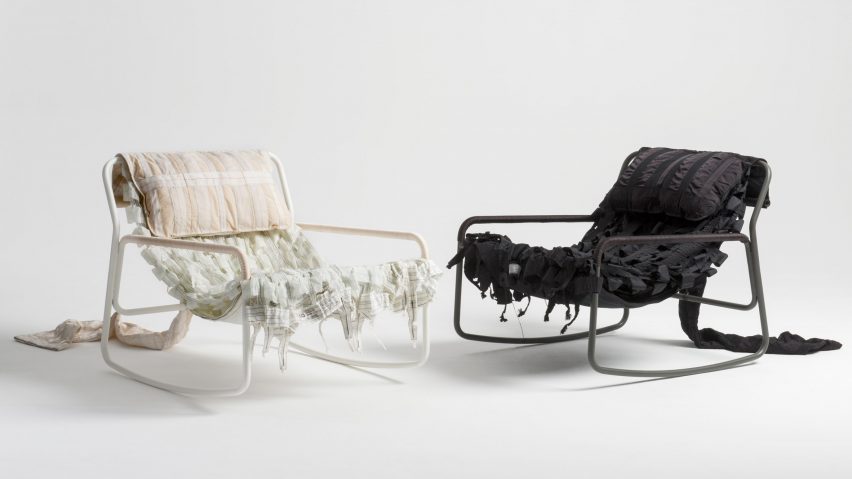Recycled parachute material wrapped over welded steel frames make up this collection of rocking chairs and screens by Benjamin Hubert's design agency Layer and the eponymous label of fashion designer Christopher Raeburn.
Comprised of three low-set rocking chairs and one screen, the Canopy collection was born from Layer and Raeburn's combined interest in "recontextualising undervalued materials".
The two studios looked to Raeburn's archives to see how the brand had previously repurposed surplus parachutes to create statement fashion pieces. These ideas were then developed to extend to furniture design.
Welded steel frameworks provided a "blank canvas" for the designers, enabling them to make the parachute material the standout element in each product.
"The Canopy Collection uses the strict geometry of the steel frames as a base on which to experiment with innovative and forward-thinking recycled parachute upholstery," said the creators.
"[It] is tuned into the semantics of a parachute in flight – the lounge chair gently rocks back and forth whilst the re-configurable screen takes inspiration from the section and construction of a wing," they added.
The designers focused specifically on using surplus ex-military parachutes and aircraft brake parachutes, made from ultra-thin ripstop nylon material, and worked with one of the head seamstress at Raeburn to create the finished products.
While all three of the rocking chairs have the same structure, each piece aims to highlight a different quality of the parachute material, from a "highly-controlled and simple expression" to a "raw, sculptural form".
Two of the chair designs boast a more tousled look, achieved by draping layers of the parachute material over their framework. One features a mixture of white and peachy tones, while the other is coloured in a palette of blacks and greys.
The other style sees a multi-coloured parachute material tightly wrapped around its metal structure for a taut finish, making it clearer what purpose the material once served.
Each of the textiles were secured with a combination of concealed zips and different textile techniques, including hidden seams and French seams. Extra parachute material has been wrapped around the armrests.
The same technique of tautly stretching the material over its frame was used for the screens, which are divided into three attached sections.
The form of each of the screens was informed by the graphic, colour-block design of the green, orange and white parachute, which features intersecting lines that play with light as it travels through the translucent material.
According to Hubert, one of the biggest challenges was templating from the military parachutes, as they contain existing panels, in addition to being very large in size and circular in form.
Rather than creating "pseudo-panels", the designers wanted to use the parachute as it was.
"At the core of the Raeburn brand is our Remade in England approach," said the brand's creative director Christopher Raeburn.
"The Canopy Collection has resulted in a truly unique opportunity for both brands to test, learn and ultimately achieve a project that's as unexpected as it is experimental," he continued.
"Raeburn shares our passion for sustainable and responsible design," added Hubert. "Together, we have translated the label's iconic use of upcycled parachute material into an exciting exploration of form and materiality in furniture."
The collection was launched during London Design Festival last week, which ran from 14 to 22 September 2019, and was displayed in Raeburn's new central London store.
Layer also released a collection of pendant lamps at this year's London Design Festival. Created for Danish furniture brand Muuto, the Strand lighting collection is made using a fibrous polymer material, intended to imitate the silkworm's act of "self-wrapping".
Layer's Benjamin Hubert was recently announced as a speaker at the upcoming Dezeen Day conference, which is taking place in London on 30 October.
Hubert will speak about how he grew his business as part of the discussion about entrepreneurialism in architecture and design.

